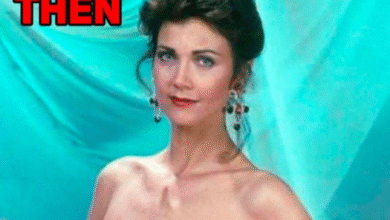Burger Giant Brand Joins Cracker Barrel Logo Feud — Fans Lose It Online

A Branding Backfire: Cracker Barrel’s Identity Crisis and the Corporate Culture Wars
In an age where rebranding decisions can ignite nationwide debates, one well-known American restaurant chain has found itself embroiled in a firestorm that goes far beyond design aesthetics. What began as a seemingly routine logo refresh has rapidly escalated into a national conversation about heritage, corporate values, and the risks of alienating loyal customers. Cracker Barrel’s recent transformation is proving to be far more than a cosmetic overhaul—it’s become a cautionary tale in the emotionally charged landscape of modern brand identity.
The intensity of the backlash has caught many industry observers off guard. Rather than fading into the background like most design updates, this controversy has drawn in political commentators, rival brands, and social media influencers. The outcry underscores how deeply customers connect with the visual and experiential elements of a brand—particularly one so steeped in nostalgia and Americana. What Cracker Barrel viewed as a modernization effort has instead been received as an erasure of cultural touchstones.
The “All the More” Campaign: A Radical Shift in Atmosphere
Cracker Barrel Old Country Store, the Tennessee-based chain celebrated for its hearty Southern fare and vintage décor, recently launched a sweeping renovation campaign dubbed “All the More.” While only about 40 locations have been affected so far, the changes represent a sharp break from the familiar rustic charm that defined the chain for decades.
Gone are the orange exteriors and walls brimming with antique tools, retro signage, and historical knick-knacks. In their place: white paint, minimalist interiors, and neatly arranged shadow boxes that have replaced the chaotic charm of the old decor. Critics argue that the redesign strips away the sensory richness that once made a trip to Cracker Barrel feel like a journey into the past.
More than a facelift, the redesign marks a philosophical shift in how the company views its identity. The original locations offered more than food—they provided a nostalgic immersion in American rural life. The streamlined design, however, leans into modern sensibilities, potentially alienating customers who valued the brand’s distinct throwback character.
The Logo Reveal That Lit the Fuse
The controversy reached new heights when, on August 19, Cracker Barrel revealed its new logo. The original featured a hand-drawn image of an old man in overalls relaxing beside a wooden barrel—an image deeply embedded in the brand’s identity. The new logo, by contrast, is striking in its minimalism: just the words “Cracker Barrel” in a clean, modern font. No illustrations. No nod to the brand’s origins.
The digital rollout triggered a tidal wave of negative reactions. Social media users flooded the company’s platforms with angry and disappointed comments, many expressing feelings of betrayal. For longtime patrons, the removal of the “old-timer” figure wasn’t just a design choice—it was a severing of the emotional ties that had connected them to the brand for generations.
Political Fuel and Corporate Shade
The logo update quickly caught the attention of political commentator Alex Bruesewitz, who denounced the change on X (formerly Twitter), claiming the brand was being destroyed by out-of-touch leadership. His post reframed the backlash as emblematic of a broader cultural disconnect between traditional values and corporate modernization—a framing that resonated with a large swath of followers and brought even more attention to the issue.
But it didn’t stop there.
Enter Steak ‘n Shake. The competing restaurant chain saw an opportunity to both capitalize on Cracker Barrel’s misstep and reinforce its own brand positioning. Reposting Bruesewitz’s message, Steak ‘n Shake added their own commentary: “This is what happens when leadership forgets who they’re serving.” They emphasized their own back-to-basics approach—highlighting the return of tallow-cooked fries and acceptance of Bitcoin payments—in contrast to Cracker Barrel’s perceived abandonment of its heritage.
A day later, Steak ‘n Shake doubled down, publishing a follow-up post that struck a deeper chord: “Heritage got Cracker Barrel this far. Now they’re erasing it. We’ll never market ourselves away from the past just to chase approval.” The message wasn’t just about brand loyalty—it was about values, family, and preserving authenticity in a changing world.
Branding, Emotion, and the Illusion of Simplicity
Steak ‘n Shake’s bold move underscored an important truth: brand loyalty isn’t just about food or service—it’s about identity, memory, and emotion. For many customers, Cracker Barrel represented more than a place to eat. It was a place to reconnect with a version of America that felt safe, stable, and familiar.
Psychologists have long noted that strong brands often become symbols of personal and cultural identity. Changes to those symbols—especially when they appear arbitrary or ideologically motivated—can provoke feelings of loss and betrayal. When nostalgia is part of a brand’s DNA, rebranding can feel like rewriting history.
Steak ‘n Shake’s commentary cleverly tapped into this psychological truth while also engaging with the broader cultural and political narratives that dominate modern discourse. Their posts straddled the line between corporate messaging and political signaling—offering both a jab at a competitor and a rallying cry for customers feeling culturally displaced.
The Bigger Picture: Minimalism, Digital Optimization, and Customer Alienation
Cracker Barrel’s design overhaul follows a larger industry trend favoring streamlined, minimalist branding. Chains like McDonald’s, Burger King, and Pizza Hut have all undergone similar simplifications in recent years, often in the name of digital clarity and modern relevance. But Cracker Barrel’s case stands out for the intensity of its backlash—a sign that the company underestimated how tightly its traditional visuals were woven into the customer experience.
Minimalist logos and clean interiors may align with digital branding best practices, but for heritage-based brands, they can also trigger perceptions of coldness, detachment, or cultural drift. Especially when rolled out without sufficient explanation or audience engagement.
Social Media as a Corporate Battlefield
What makes this controversy especially instructive is how rapidly it escalated—and how public it became. In a pre-social-media era, dissatisfaction over a logo or decor shift might have stayed limited to store comment cards or word-of-mouth grumbling. Today, a single design decision can go viral, morphing into a national debate with economic, political, and cultural implications.
Steak ‘n Shake’s social media strategy is a glimpse into a new competitive era where companies don’t just sell—they spar. Branding controversies have become real-time marketing opportunities, and customer outrage is a resource to be mined for clicks, shares, and conversions.
Even their offhand reference to Bitcoin served a purpose: aligning their brand with innovation, independence, and perhaps even anti-establishment leanings—all while roasting a rival.
Silence or Strategy? Cracker Barrel’s Measured Response
Throughout the storm, Cracker Barrel has remained mostly quiet—releasing only bland statements reaffirming its commitment to customers and values. Whether this reflects strategic caution or wishful thinking that the issue will fade is unclear. But as the backlash shows no signs of abating, many experts suggest a more proactive approach may be necessary.
Acknowledging the emotional core of the criticism—not just the aesthetic objections—may be key to regaining customer trust. Yet doing so would require admitting missteps, which could undermine leadership and invite further scrutiny.
A Corporate Wake-Up Call
Cracker Barrel’s identity crisis holds valuable lessons for any company considering a brand refresh:
- Heritage matters—especially when your identity is rooted in nostalgia.
- Customers feel ownership over long-standing brands. Change too much, and they may feel betrayed.
- Competitors are watching, ready to exploit your missteps in real time.
- Social media is an amplifier, and the court of public opinion now judges brands just as harshly as their shareholders do.
As this situation unfolds, it’s becoming more than just a case study in branding—it’s a warning. Modernization efforts that ignore customer identity, emotional attachment, and cultural resonance do so at their own peril. Cracker Barrel’s journey will no doubt shape how other legacy brands tread the fine line between reinvention and alienation.



